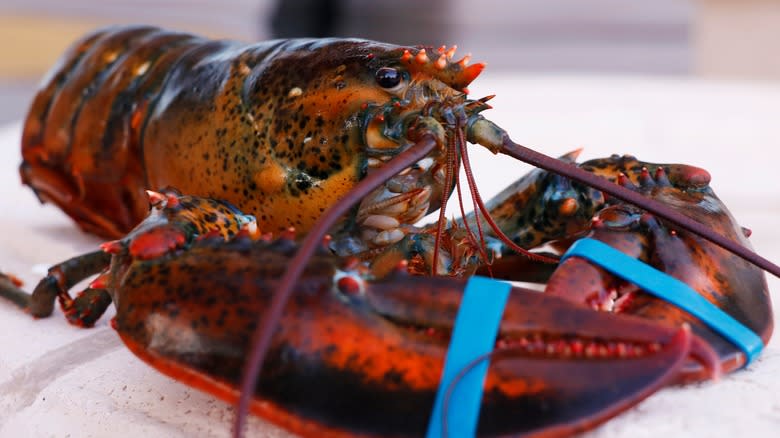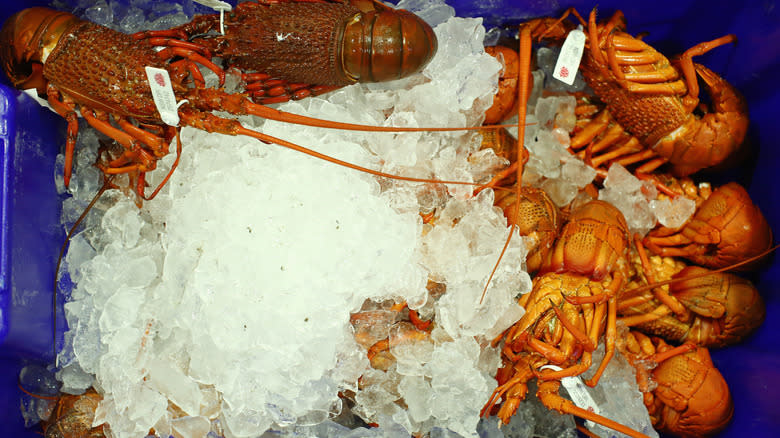The Storage Tip To Remember If You Can't Cook A Live Lobster Right Away

Lobster, beloved for its delicate flavor and succulent meat, has long been celebrated as a prized delicacy in the realm of seafood. However, you may be wondering what to do when you procure a live lobster but are unable to prepare it immediately. The challenge of how to store it while maintaining its freshness and ensuring the crustacean's well-being poses a unique conundrum for seafood lovers intent on preparing lobster at home.
Although the universal advice is to cook live lobsters the same day they are purchased or delivered, aficionados generally agree that they can last somewhere between 24 and 48 hours in the refrigerator before they must be cooked and consumed. Lobster Anywhere, a delivery platform, recommends storing the creatures for up to 24 hours in a brown paper bag with either some damp newspaper or fresh seaweed inside in the coldest part of the fridge (best kept at around 40 degrees Fahrenheit).
Ultimately, the key is to keep the lobsters as cold as possible without freezing them. Peek in on the crustaceans sporadically to ensure they are still moving, but put on a pot of water to boil as soon as possible if you notice movement has decreased or stopped.
Read more: 13 Tips To Make Your Shrimp Taste So Much Better
What To Avoid When Storing Live Lobster

Freezing them is a definite no-no, but not for the reason you may think. Although it's true that freezing and thawing raw lobster can destroy the delicate flavor, result in a mushy mess, and also possibly lead to toxins developing, it's more problematic for the deshelling process. Because of the high water content, raw lobster meat will expand beyond the shell when frozen. The proteins and texture become damaged, the meat sticks to the shell, and separating the two becomes a nightmare.
It's also important to not expose lobster to tap water. Doing so poses a critical threat to their survival because of the disparity in salinity levels. These saltwater-dwelling creatures are used to the ocean environment and exposing their salty blood and tissue to freshwater can disrupt their equilibrium and kill them. Similarly, storing live lobsters in an airtight container poses a significant threat to their well-being and survival. This can quickly result in distress, ultimately causing irreversible harm to them and even suffocation.
How To Prepare Your Lobster

Whether you've stored it in the fridge for a day or so or are moving immediately to the cooking phase, the possibilities for lobster preparation are endless. For perfectly poached lobster tails simmer a pot of water and then pour it over the shelled tails, letting it sit for four and a half minutes. Then remove the meat and saute it in butter for a meal that's packed with incredible flavor.
For a sans-shell option, consider our recipe for lobster linguine with white wine sauce. A lemony white wine sauce with sauteed shallots drizzled over linguine with mounds of freshly cooked lobster meat, all finished with a sprinkle of Parmesan cheese, is the ultimate indulgence dinner. Or opt for our homemade lobster rolls. This quintessential New England delicacy is crafted with chilled, succulent lobster meat, mayonnaise, celery, onion, and a zesty hint of lemon juice. A hot dog bun toasted in melted butter becomes the perfect vessel for this fan favorite.
Read the original article on Daily Meal.

